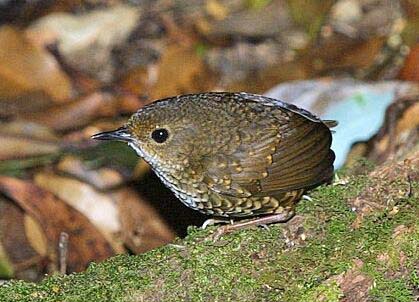
a web page by Don Roberson |
CUPWINGS Pnoepygidae |
|
Gelang et al. (2009) did not propose an English name of the birds within this new family. I had initially used the name "Pygmy Wren-babblers" because it is the name of the most widespread species, and because these are very tiny "wren-babblers," but that was clearly inadequate. The 2011 update of the Clements world checklist calls them "cupwings," and I follow (see below). |
The Pnoepyga cupwings are very small, short-tailed, semi-terrestrial birds with slender bills and diminutive front claws. Their tails consist of six extremely short rectrices, often concealed by long rump feathers. Three of the four species come in two color morphs; the one shown above is the pale, or "white-scaled" morph of Pygmy Cupwing. This species ranges from the Himalayas of Nepal and India through montane southeast Asia to the Indonesian islands of Java and Timor (Collar & Robson 2007). There are three other species of Pnoepyga in this new family:
All these tiny birds live in tangled undergrowth, singing distinctive warbler-like songs, and move by hopping. It has been quite some time since I saw one, but reading of them now suggests to me that they may compared to the small, semi-terrestrial tapaculos of the Andes. |
| There are about a half-dozen other genera that are called wren-babblers (e.g., Rimator, Ptiolcichla, Kenopia, Napothera, Spelaeornis), and the DNA evidence does suggest that most of them are, indeed, babblers with the family Timaliidae, but even there they divide again into two sub-families (see Timaliidae). It is obviously best to call this new family something other than "wren-babbler." Inskipp et al. (2010) noted the conundrum and had several suggestions, the best of the which was "cupwing," in part because the Latin name Pnoepyga means "cupped wing." The name is short and punchy, and the birds do have very short 'cup-shaped' wings in addition to very short tails. |
Photos: Suppalak Klabdee photographed the Pygmy Cupwing Pnoepyga pusilla in Doi Inthanon NP, Thailand, in Feb 2002. Bibliographic note: There is no "family book" on this new family, but a good introduction to the genus, with photos, is in Collar & Robson (2007). Literature cited:
|
 Gelang
et al (2009) undertook to determine the evolutionary relationships of
many babblers by sequencing mitochondrial and nuclear DNA of 59 babbler
species in 46 genera; their work did sort out the major lineages. But
there was a big surprise. Genetic analysis of the "wren-babblers" in
genus Pnoepyga showed that these did not belong within the
babbler assemblage. The researchers did not know exactly where to
place this "long-branch" lineage, but it is clearly not within the two
main babbler families,
Gelang
et al (2009) undertook to determine the evolutionary relationships of
many babblers by sequencing mitochondrial and nuclear DNA of 59 babbler
species in 46 genera; their work did sort out the major lineages. But
there was a big surprise. Genetic analysis of the "wren-babblers" in
genus Pnoepyga showed that these did not belong within the
babbler assemblage. The researchers did not know exactly where to
place this "long-branch" lineage, but it is clearly not within the two
main babbler families,